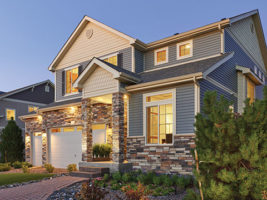Can I Install James Hardie Siding Myself?

Can I Install James Hardie Siding Myself? James Hardie siding is one of the best options for Florida homeowners that want durable and aesthetically appealing siding on their home. If this is something you desire for your residence, it’s likely that you’re looking for renovation companies to install this durable product for you. However, some homeowners may start to wonder if they can save some money by installing fiber cement siding themselves. While this can be a more affordable option, there are many reasons that you should opt to have your James Hardie fiber cement siding installed by trained professionals.
One of the main disadvantages of installing James Hardie siding yourself is that it’s a very heavy product. While this is a positive when it comes to adding durability to your home, it also makes it very difficult to install yourself. In fact, it usually takes a team of contractors to work together to complete a fiber cement siding and is never done as a one-person job. In addition, the installation of fiber cement siding can utilize expensive tools that many homeowners wouldn’t have just lying around their home. The cost of purchasing all of these tools can add up quickly and they aren’t a great investment if you’re never going to use them again.
In addition, one more problem with installing James Hardie siding yourself is that it can potentially void your warranty. Many warranties come with stipulations that can be voided by improper installation of studs and other accessories. This means that even a slight mistake in your DIY installation can result in having to pay out of pocket for expensive repairs down the road.
Morgan Exteriors Installs James Hardie Siding for Florida Homeowners
If you’re ready for the most durable siding for your home, then the James Hardie siding offered by Morgan Exteriors is the right choice for you. James Hardie siding is formulated from a specialized blend of wood pulp, cement, water, and filler so that it lasts for many years without sustaining the damage that plagues lesser siding materials.
Some of the benefits found within the James Hardie siding that we offer include:
- Resistance to damage caused by insects
- Resistance to moisture infiltration
- Long-lasting color retention
- Fire resistance
Frequently Asked Questions About the James Hardie Siding Installation Process
We’ve compiled some frequently asked questions about the James Hardie siding installation process:
How to Hang Siding on a House?
Hanging siding on a house involves the following general steps:
- Step 1: Preparation – Ensure the exterior walls are clean, dry, and free from any old siding or debris. Install a weather-resistant barrier or house wrap to protect against moisture.
- Step 2: Measure and Cut – Measure the dimensions of the wall to determine the amount of siding needed. Cut the siding panels to fit the appropriate lengths using a saw.
- Step 3: Starter Strip – Install a starter strip at the bottom of the wall to support the first row of siding.
- Step 4: Install Siding Panels – Begin installing the siding panels from the bottom and work your way up. Use appropriate nails or screws to secure the panels to the wall, leaving a small gap to allow for expansion.
- Step 5: Overlapping – Ensure each siding panel overlaps with the one below it to create a weatherproof seal.
- Step 6: Trim and Finishing – Install trim pieces around windows, doors, and corners for a polished look.
Of course, the siding installation process should only be conducted by trained professional siding contractors like those at Morgan Exteriors.
Is it Hard to Install Siding?
The difficulty of installing siding can vary based on the type of siding material and your experience with DIY projects. Some siding materials, like vinyl siding, can be relatively straightforward to install for someone with basic carpentry skills. On the other hand, materials like fiber cement (Hardie board) may require more expertise due to their weight and special cutting tools needed.
While some homeowners may be comfortable with DIY siding installation, it’s important to remember that professional siding contractors have the expertise, tools, and experience to ensure a proper and efficient installation.
What Is the Best Way to Install Hardie Board Siding?
The best way to install Hardie board siding is to follow James Hardie’s official installation guidelines and recommendations. Here are some key points to consider:
- Use appropriate safety gear, such as gloves and eye protection, when handling Hardie board siding.
- Use a circular saw with a fiber cement blade to cut the panels and install them with corrosion-resistant nails or screws.
- Leave a gap of 1/8 inch between the siding panels to allow for expansion.
- Flash and seal around windows, doors, and other openings properly.
- Follow proper painting and caulking procedures for a finished look and to protect the siding.
For the most reliable and durable installation, it’s recommended to hire experienced professionals who are familiar with Hardie board siding installation.
How Much Does It Cost to Install Hardie Board Siding?
The cost of installing Hardie board siding can vary depending on several factors, including the size of your home, the complexity of the installation, regional labor rates, and any additional preparatory work needed.
Contact Morgan Exteriors today for a no-cost consultation to get a more accurate estimate based on your specific project requirements.
Please note that these answers are general guidelines and may not cover all the intricacies of siding installation. Always refer to manufacturer guidelines and consult with professionals for your specific project.
Contact Us Today!
For more information about the fiber cement siding we install and why it’s a great choice for your home, contact Morgan Exteriors today. When you do, we’ll happily answer any questions you may have about our products and services.














